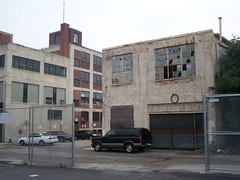Industrial land needs a separate property tax classification too
As long as industrial land is valued as if it can be office buildings, it too will be reused for different purposes. Furthermore, as long as churches and schools are matter of right uses in industrial zones, these uses will crowd out production-distribution-repair uses, because these uses can outbid industrial uses, because economic viability based on economics of industrial firms will be trumped by the noneconomic considerations of non-industrial users who covet the land that they can get more cheaply, because it is zoned industrial.
For more thinking about property tax revenue and classification issues, see the current newsletter, "Assessing New York City's Property Tax—Yet Again" from the Center for Rethinking Development at the Manhattan Institute. The organization focuses on New York City, but the thinking is relevant to all cities.

Warehouses on Reed Street at Channing Street NE. Located within two blocks of the Rhode Island Avenue Metro Station, these buildings are in effect, "mothballed," while the property owner waits for better redevelopment opportunities.
Labels: intensification of land use, land use planning, property development, property tax assessment methodologies



0 Comments:
Post a Comment
<< Home